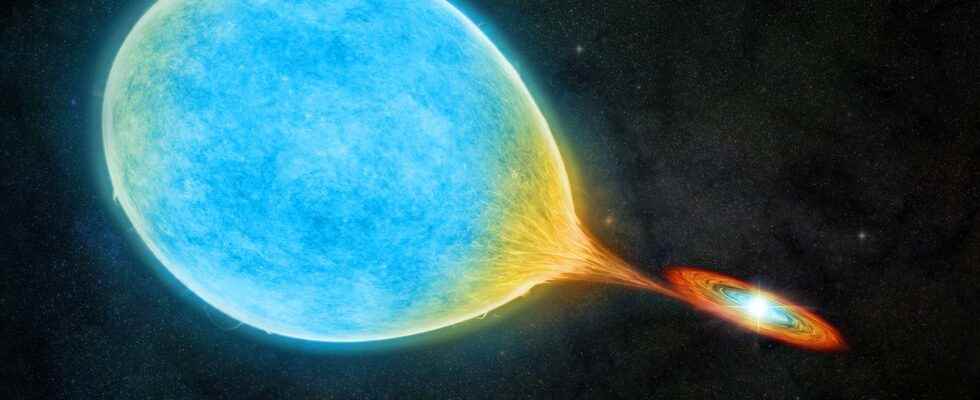The more massive the stars evolve, and vice versa. The theory which explains this fact also makes it possible to date them, but it led to give an age clearly higher than that of the observable Universe in the case of certain stars. The solution to this riddle involves a scenario that has just passed successfully tests.
The pioneers ofastrophysics from XXe century are at the origin of a theory of the stellar structure already well developed before the second world war. She was refined by advances in nuclear astrophysics after this war and with the rise in power of computers and methods of analysis digital. Finally, it allows us to think about and describe the evolution of stars. This will depend in the first place on their masses.
The calculations then make it possible to estimate in how long a star will become a white dwarf or turn into supernova for example, although no precise date can be brought forward. The whole history of stellar astrophysics in the second half of the last century has shown that the theory of stellar structure and evolution is remarkably successful. It is therefore with great surprise that astrophysicists found that when applied to certain white dwarfs of low mass, it led to assigning them an age greater than that of theUniverse observable yet well established, by combining different observations such as those concerning the fossil radiation speak Planck satellite.
The standard cosmological model is also remarkably confirmed, even if we are currently confronted with the enigma of the discrepancies of the estimates of the famous Hubble-Lemaître constant which also gives an estimate of the age of the observable cosmos, astrophysicists sought a way to explain why these white dwarfs seemed to contradict either the theory of evolution stellar, that is cosmology. In fact, a possible solution had been found.
We know that the stars, at least in the Milky Way, are most often in a relationship in binary systems. It can happen during the evolution of stars of those couples that one begins to tear away from the other matter via from tidal forces gravitational.
About 97% of the stars in the Milky Way will become white dwarfs and the problematic ones have masses less than 0.3 solar masses, they are called in English extremely low mass (ELM) white dwarf, which can be translated as “extremely low mass white dwarf”. The ELM-type white dwarfs, although rare, are found precisely among binary systems and as far as is known only in these systems.
The scenario envisaged to solve the enigma of stars older than the Universe is then the following.
It all starts with stars on the main sequence from which a classic white dwarf tears material. Usually, we speak of such systems in terms ofvariable stars cataclysmic (CV in English). We currently know more than 1,600 examples in the Milky Way and they have a orbital period typically between 80 minutes and 12 hours.
The first part of this animation shows a scenario similar but not identical to that of the formation of an ELM-type white dwarf. The second part conforms to the scenario of an SN Ia supernova. © CAASTRO, Swinburne Astronomy Productions
Evolving stars accelerated by tidal forces
It may happen that theaccretion matter on the white dwarf sets off thermonuclear reactions leading to a violent explosion but not leading to the destruction of the star, so a new explosion for the same reasons may occur later. This is called a nova for this type of explosion.
But it can also happen that the accretion of matter is sufficient for the mass of the white dwarf to exceed the famous Chandrasekhar limit, about 1.4 solar mass. The star is no longer stable, it collapses, thermonuclear reactions engender but much more violent, so that the resulting explosion destroys the whole star. It is a type supernova SN Ia.
White dwarfs exotic of ELM type would then initially be stars on the main sequence but the companion white dwarf would not start tearing material until late in the star’s life, when it begins to burn its heart.helium while the base of the envelopehydrogen surrounding this heart is also the seat of reactions of fusion thermonuclear.
At one point, the future ELM-type white dwarf ceases to be the victim of her white dwarf because the transfer of matter stops. There is only one star left with a mass less than 0.3 solar mass which will eventually turn into a white dwarf. We then obtain a star which would take longer than by the normal way to form with such a low mass (the higher the mass of a star, the faster it evolves and vice versa).
Today, this scenario has just been tested by a team of astrophysicists who used several instruments such as the telescope Shane at Lick Observatory in California along with data from the mission Gaia, as explained in a publication in Monthly Notices of the Royal Astronomical Society and which can be found in free access on arXiv.
Astrophysicists have indeed observed dozens of stars deformed by tidal forces and having the expected star characteristics in transition from the main sequence to the final ELM-type white dwarf state, that is, when the star lost most of its mass and nearly contracted into a white ELM dwarf.
The riddle therefore seems to be solved.
Interested in what you just read?
.
fs3
